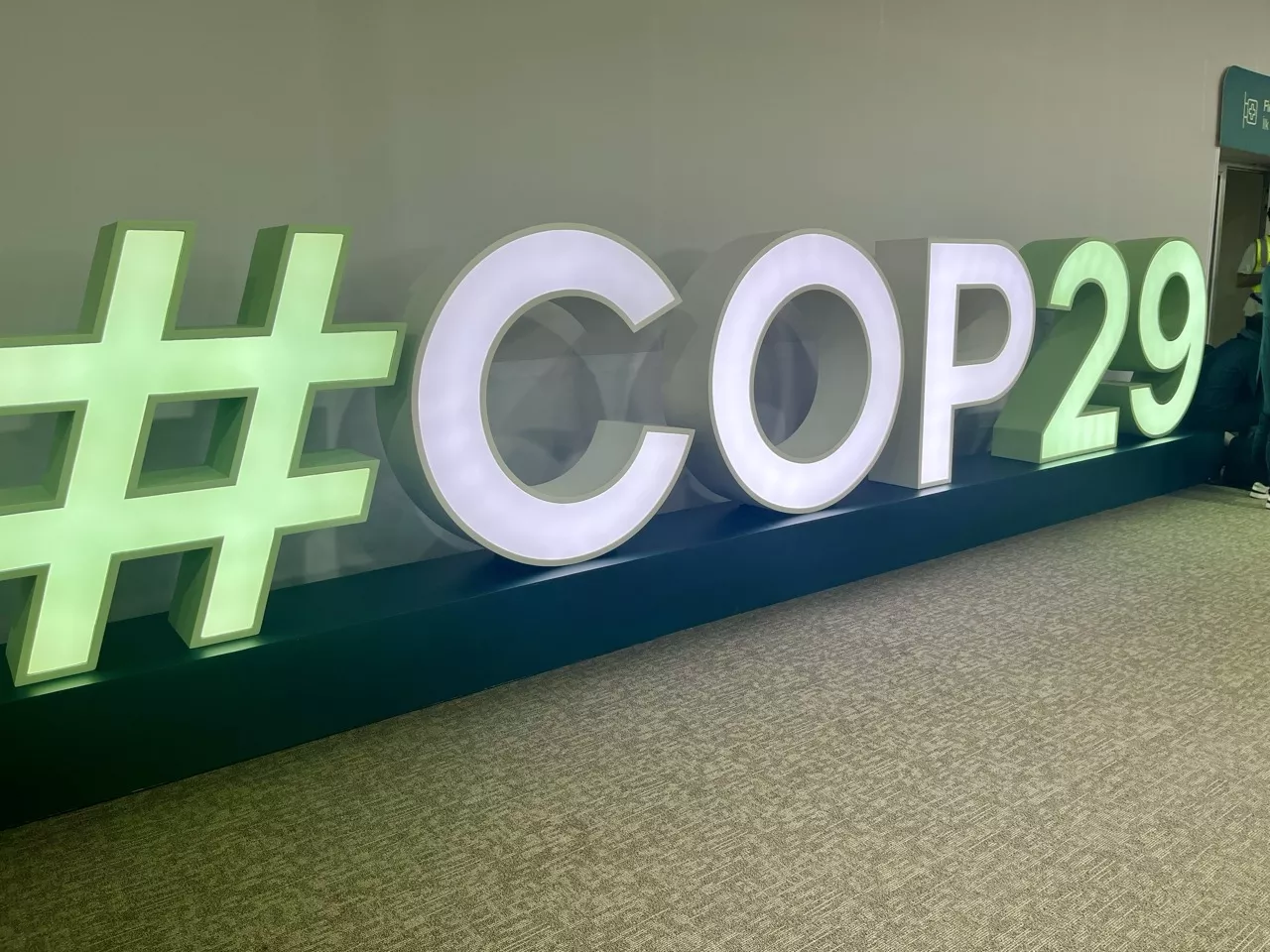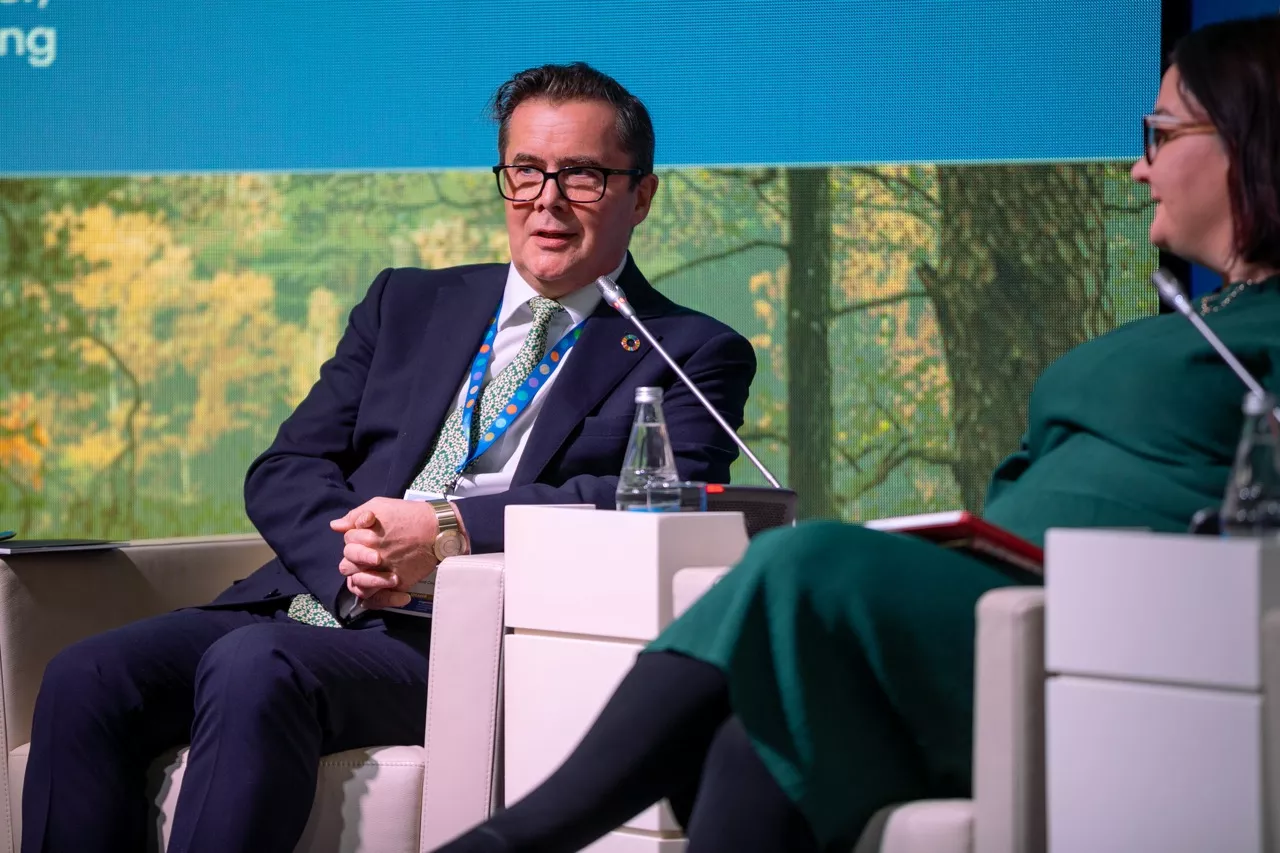Back from Baku - news from our COP29 correspondent
25 November, 2024
I have just returned from almost a week in Baku, Azerbaijan, having attended (and sometimes contributed to) a number of forums and events at (or around) #COP29, the annual focal point of the United Nations’ climate change considerations and negotiations. This mammoth event is the largest global multilateral meeting of governments, academics, business leaders and NGOs on the international calendar, although there is often some controversy regarding who should attend and whether their presence will contribute to progress.

As I write this, the world’s governments are still wrangling on a wide range of issues, as they struggle to agree a statement and policies that might signify some form of progress. But, awaiting their conclusions, I will offer my impressionistic view of some aspects of the discussions and debates I encountered in Baku, and particularly those that have some relevance to my professional roles and responsibilities.
First, this was a smaller gathering than the climate COPs of recent years - although it's difficult to comprehend how it could grow much larger than the sprawling events in Egypt and the UAE. Things got off to a rocky start with opening comments from our hosts which set an unfortunate tone (causing some diplomatic friction) and amplified questions raised previously about the intentions and integrity of their Presidency.
This fractious mood and a fairly low level of expectation, coupled with speculation regarding the possible fallout from the recent US election, was what I encountered on arrival. However, as the week progressed, attitudes seemed to become more positive. Even when commenting on recent geopolitical shifts and headwinds, many of the climate change professionals and veteran policy advisors expressed a firm determination to continue driving forward. Not surprisingly, they reiterated the simple but important point that the problem is not going away – indeed, science tells us it will only get worse - and averting our eyes, turning our backs, or denying it exists will only exacerbate our inability to manage the looming catastrophic consequences.
As a balance against the initial ‘gloom’ in Baku, I have below offered some summary indicators of recent progress offered by the Marrakech Partnership in its ‘Yearbook of Global Climate Action 2024’, including:
- A 14% increase in global renewable energy capacity in 2023;
- A 77% increase (since 2022) in global investment in clean technology manufacturing;
- A 35% growth in global zero-emission vehicle sales in 2023;
- A quadrupling of climate-focused investments, with a redirection of capital totalling US$555 billion in 2023.
For many, the scale of change and accelerating momentum behind the #transition economy is now irreversible. Therefore, one of the desired outcomes of COP should be additional clarity on how to further facilitate and scale – and fund! - these trends, while securing and safeguarding progress in countries and regions that lack the resource or capacity to do so.
This was very much the prevailing sentiment expressed by many of the investment and policy leaders speaking at the key ‘side-events’ I attended: Climate Action’s Sustainable Innovation Forum and, particularly, the World Climate Summit, organised and hosted by our long-standing partners at the excellent World Climate Foundation.

The World Gold Council chooses to primarily focus its time and efforts at COP on these events, particularly the latter (#WCS2024), as they typically offer a far more concentrated and focused set of discussions and engagement opportunities, when compared to the vast cacophonous environment of the UNFCCC’s Blue Zone. I did, however, venture into this colossal and chaotic space, which not only hosts the official negotiations, but also houses a vast array of national pavilions and civil society groups and NGOs. I admit that usually I get lost among the many hundreds of stages and speaking platforms in the Blue Zone, but this year I managed to navigate my way round and find my intended destinations without too much hassle. And I was glad I did.
Whilst there, I was invited to attend panel discussions on the role of international standards and customs authorities in advancing a decarbonising economy, and mining industry perspectives on the relationship between sectoral sustainability standards and the secure supply of critical minerals. I also had helpful conversations on the scope and development of ISO’s coming Net Zero standard (which I will be following up on to explore its further implications for the #gold supply chain). Finally, I met with research experts to consider new approaches to assist downstream gold market participants in arriving at firmer and clearer estimates of their carbon profiles. All of these were helpful, and this is one simple benefit of being at COP – the sheer volume of expertise at hand.
That said, and as pleased as I was to spend a day or two in the Blue Zone (courtesy of our friends at the ICMM and ISO), I can only applaud those that survive the full two weeks of COP and emerge with clarity of mind and purpose intact. Maintaining the ability to hear the ‘signal’ against the competing barrage of ‘noise’ from so many divergent perspectives and opinions is quite a challenge.
One opinion that was voiced by some old hands at the UN, and which I may have alluded to above, was the nature of the wide range of participants that now attend or ‘surround’ COP, with accusations that some attendees represent interests (fossil fuel producers) that run counter to the overall objective of proceedings. There is, therefore, something to be said for the idea that COP hosts should strive to ensure a clear level of credibility and commitment to the UNFCCC goals (and the Paris Agreement) in the organisations they invite to attend and participate. But I also think that a very strong case can be made for ensuring that the event continues to attract a healthy and diverse set of what are typically referred to as ‘non-state actors’ (or ‘non-Party stakeholders’) – that is, companies, investors, city leaders, and civil society organisations. I suggest that these entities, if not integral to COP proceedings, should have established channels to make their voices clearly audible to government delegations as they haggle over their commitments or make pleas for greater assistance. In my opinion, institutional investors and responsible business leaders have been pivotal in driving the global climate agenda forward, showing leadership when governments have all too frequently stalled, prevaricated, or flip-flopped on climate actions.
This perspective underpinned some of the points I tried to articulate on the stage and at a dedicated briefing session hosted by the WGC at the World Climate Summit. Even when UN Parties can come to agree on high-level policy objectives and funding commitments to facilitate mitigation and resilience solutions, there is often a gap regarding how these agreements translate into ‘real-world’ actions. More specifically, the world is often left pondering how and who will implement the called-for solutions ‘on the ground’ at particular locations – i.e. where solutions are most needed but also often least accessible.
I was pleased, therefore, to be able to point to many of the examples of our member companies at the WGC; forward-thinking gold mining companies who, in seeking to decarbonise their operations, are often the first movers and major catalysts in bringing renewable energy to locations where it would otherwise not exist. Similarly, they often act to build local resilience while, increasingly, extending their plans to consider collaborative community-focused solutions and protective measures for surrounding ecosystems. These actions are of real consequence in impacting how local people, at and well beyond mine-sites, experience climate change. I illustrated my comments by offering practical examples of progress from two member companies – Sibanye Stillwater and Torex Gold; both very different, but both demonstrating a consistent pattern of action to advance decarbonisation, and nature and community resilience.

I was also pleased to be able to highlight the broader efforts made by the global gold sector in coming together to collaborate, to share good practice, and identify practical climate-focused solutions. I am proud of the work the WGC has done to facilitate this convergence and explained this to a small audience at our ‘Beyond Net Zero’ session at the WCS. This also aligned with a theme that featured in discussions at other events I attended; the need for greater collaboration across supply chains to ensure more consistent and impactful decarbonising plans.
Another theme that was more prevalent at this year’s COP was consideration of the role and challenges around the materials and metals needed to build a transition economy – the so-called ‘critical minerals’ required to build clean energy technologies and infrastructure. I have made the point before that that gold is not defined by most governments as ‘critical’ - largely because its supply is not threatened or constrained. But when it comes to implementation of key clean technologies and resilient infrastructure, particularly in remote locations and developing economies, the actions of responsible gold mining companies are often absolutely vital. In some instances, they are the only driver of positive change.
Whenever returning from these COPs, there is always the question of whether attendees now see the global ‘state of play’ (of climate change policies and plans) in an optimistic or pessimistic light. Given we’re still not clear on the likely final outcomes, I will avoid any second guessing, but noises currently emerging after recent draft ‘deals’ from the Azerbaijani Presidency are anything but celebratory. There is, of course, always a hint of pessimism ‘baked in’ when considering the climate-focused decisions of our governments. However, I like to think the climate community remains, essentially, an optimistic bunch and, so, I will conclude by offering a few Reasons-To-Be-Cheerful from COP29:
- An agreement has finally been reached on what is known as Article 6 (of the Paris Agreement) on Carbon Markets. Ideally, this will facilitate a more robust system of carbon credit trading to flourish that will unlock finance for developing countries and, at least by implication, nature-based solutions (in the development and protection of ‘carbon sinks’).
- Over 30 countries committed to reducing methane from organic waste. This is a significant contributor to global warming and if this commitment is translated into action, alongside the broader Global Methane Pledge, it could offer a quick win in lowering emissions.
- In the absence of (or whilst waiting for) national-level ambition, cities and local regions are driving ahead. As Vasco Cordeiro, President of Europe’s Committee of the Regions stated, “We don’t have the luxury to wait for the other instances to find agreements, but … have a responsibility to step up our climate action.”
- Finally, and closer to home, the gold industry can be confident it is making a substantial contribution to progress on climate mitigation and local adaptation. It needs to keep moving, but has, in many instances, shown real leadership, and my experience at COP29 suggests this has not gone unnoticed.
